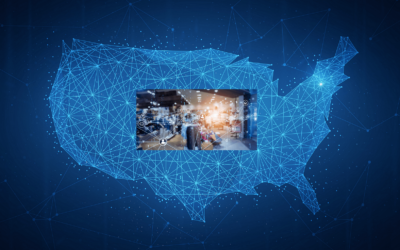Field service management teams want to keep costs down while improving service relationships, which isn’t easy to do unless those teams have the right tools to enable them to understand exactly what is happening where machinery lives.
Before IoT, lack of context and communication led to expensive delays, downtime, loss of productivity, and even loss of reputation. Automation, IoT, and Industrial IoT (IIoT) delivered huge breakthroughs in field service, helping organizations create lasting relationships.
Today, devices can independently contact field service platforms and technicians, and agencies with specific details about what may be happening that represents a potential problem. With policies created for specific machinery, for example, alerts can be sent when a machine hits a certain temperature, is vibrating, is shutting itself down, and more.
In the past, these problems went undetected for hours or even days and couldn’t be resolved until a visit from a technician was scheduled. Today, with AI-enhanced automation, problems can be completely resolved with remote machine controls or can be more easily resolved when techs are made aware of the issues and can fix them from a centralized location.
According to Market & Markets, the field service management market worldwide is expected to grow with a CAGR of 18.0% during the forecast period from 2022 to 2030, starting from US$ 4.82 Bn in 2021. Increasing adoption of cloud-based field service management solutions and mounting demand for agility for quick solutions will drive the field service management market.
Market & Markets defines the “field service management” domain as a set of tools used for operational efficiencies in organizations. It enables the integration of accounting, billing, distribution, and servicing. It offers real-time communication in a working environment. Due to varied benefits, we expect that the field service management market will show significant growth during the forecast period.
We caught up with Jeff Li, Senior Director, Risk, Governance, Partners, and Projects at ConnX, a large, global enterprise Managed Services and System Integration company based near Princeton, New Jersey, to learn about their investment in expanding beyond traditional “IT” to “OT” offerings.
“Devices enabled with self-diagnostic capabilities report on performance, reducing the need for in-person technician visits for inspection while also providing valuable data on what is happening across hundreds of thousands of devices, which gives companies responsible for ensuring machines are up and running at their peak a huge competitive advantage,” Li said.
“This is a risk-management move, in many respects, but also simply a way to drive down costs while driving up knowledge and operating efficiencies,” Li said. “For example, if a service visit is warranted, Connected Field Service applications allow technicians to arrive with exactly what they need without a return visit. Reduction in initial and return calls with the correct part, as well as an increase in call efficiency for needed services, enables technicians to get more done. The pivot to this area, after thirty years of keeping large, distributed enterprise networks operating with no downtime, was simple for us to provide and embraced by our customers.”
Li also explained that “While service once meant fixing broken devices, IoT has enabled more proactive use of data for anticipating needs, and this is the same across traditional telco network devices and edge devices – down to smartphones and computers – which is why we are so excited about our expansion into this market. By utilizing mobility, cloud technology, and big data to optimize predictive maintenance, just as we can make sure voice, data, video, and messaging services are always up and operating, we can do the same for any other connected device.”
As a Microsoft Gold partner for decades, Li is a fan of Microsoft’s approach, seamlessly blending human collaboration applications like Teams with cloud and IoT applications using Azure IoT technologies.
“Microsoft has been a leader in this domain, an offshoot of Industry 4.0, by combining their expertise RTC and their expertise in IoT and Industrial IoT with the Azure cloud making it possible to analyze information generated at the network edge to understand where machines are performing – or not,” Li said.
“Equipped with features including asset location and management, remote detection of anomalies, automated scheduling recommendations, resource management, service level agreements, and more, Microsoft is bringing together powerful elements that, in combination, ensure first-time and sustainable fixes, by equipping technicians and service managers with the right tools and information to proactively resolve the issue.”
Li believes managing machines and people together has become a science and an art. The same principles apply, especially at the edge where so much automation is happening.
“The bottom line: no downtime means happier customers and higher profits,” which explains the growth and anticipated growth in the Connected Field Service are for Microsoft, and similar companies, including ServiceNow.
“First, unified real-time communications at the edge is meeting the information view,” Li said. “On the same secure networks, organizations can access real-time updates on technician’s availability, on-hand goods inventory, legacy and new telematics systems, location, and scheduling.
Second, predictive field service and advanced forecasting is making it possible to dramatically reduce failures of machines before they happen.
Third, collaboration platforms like Teams, sometimes integrated with CRM and workflow solutions like Microsoft Dynamics, make it simple and intuitive to coordinate communications between customers, help desks, field technicians, and experts who can meet in real-time to solve problems, helping an onsite tech fix an expensive machine, or by completely avoiding a truck roll by working with the company’s operating crew on the factory floor,” Li explained.
Li said one of the biggest trends in connected field service is the rapid adoption of Augmented Reality and Virtual Reality. “These technologies are having a significant impact on field service applications which can replace bulky and quickly out-of-date operator manuals and handheld devices with better user experience and hands-free capabilities. AR and VR devices make necessary information easily accessible in an immersive format that includes digital twins, 3D illustrations, video-driven instructions, and real-time feedback if connected to an in-house technician if needed.”
It is at this intersection between people and machines that Li is seeing unlimited potential.
“By offering a detailed digital visualization of the asset and the steps required to fix problems, technicians need less training, and one technician can do the work of ten,” Li said.
According to a recent study by Allied Analytics, the rise in the need to keep track of activities taking place in a field, increase in demand for mobility for getting real-time visibility, rise in adoption of automation & digitalization in the field services industry, an increase in the adoption of Internet Of Things (IoT) which drive the adoption of cloud-based FSM solutions, and the integration of AI, AR, and VR in the field services sector is driving the growth of the global field service management market.
The global field service management industry generated $5.2 billion in 2021, the firm forecasted and is estimated to reach $29.9 billion by 2031, witnessing a CAGR of 19.2% from 2022 to 2031. The report offers a detailed analysis of changing market trends, top segments, key investment pockets, value chains, regional landscape, and competitive scenario.
Originally posted on The Frontier Hub – Industrial Innovation.









